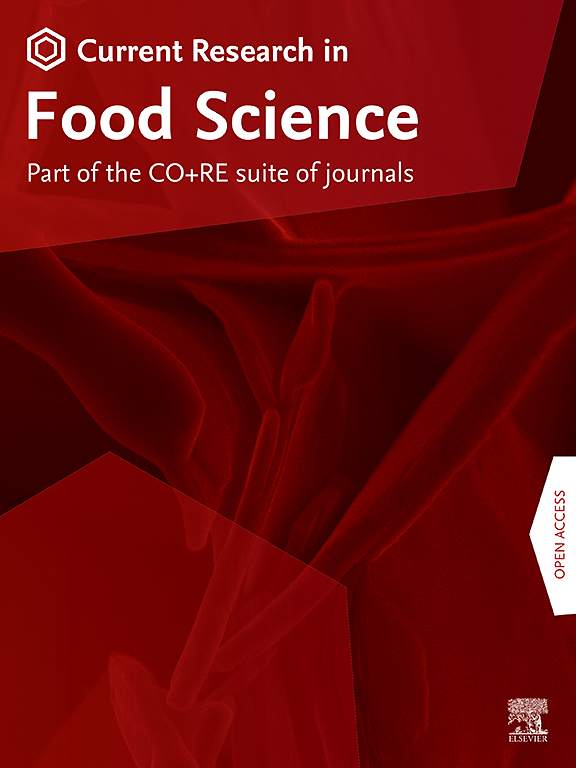罗非鱼-大豆双蛋白的制备、结构表征和功能特性:不同络合方式的影响
IF 7
2区 农林科学
Q1 FOOD SCIENCE & TECHNOLOGY
引用次数: 0
摘要
罗非鱼分离蛋白(TPI)的功能特性有限,如低溶解性、乳化性和起泡性,限制了其在食品工业中的应用。然而,将其与亲水性蛋白结合可以改善这些性能。不同的组装方法可能会影响得到的双蛋白的结构和功能。为此,采用物理混合、ph调节络合和ph调节共沉淀的方法制备了罗非鱼-大豆蛋白混合物(T-SPM)、配合物(T-SPC)和共沉淀物(T-SPCP)。分析了这些方法对罗非鱼-大豆双蛋白结构和功能特性的影响。结构分析表明,TPI在ph调节下通过非共价力和二硫键与SPI结合,导致结构发生变化。与T-SPCP相比,T-SPC表现出更多的亲水基团,游离巯基、二硫键、α-螺旋和zeta电位增加,表面疏水性降低,片状结构变小。功能分析表明,与T-SPM相比,ph调节的组装方法显著提高了双蛋白的性能。T-SPC比T-SPCP具有更高的溶解度、乳化能力和发泡能力,T-SPCP在共沉淀过程中pH值调整为4.5,具有更大的聚集结构,从而具有更好的热稳定性。因此,通过ph调节从12.0到7.0组装的T-SPC显示出优越的特性。本研究为功能性双蛋白的开发及其食品工业应用提供了理论基础。本文章由计算机程序翻译,如有差异,请以英文原文为准。

Preparation, structural characterization, and functional properties of a tilapia-soybean dual proteins: Effects of different complexation modes
The limited functional properties of tilapia protein isolate (TPI), such as low solubility, emulsification, and foaming, restrict its use in the food industry. However, combining it with hydrophilic proteins can improve these properties. Different assembly methods may affect the structure and functionality of the resulting dual proteins. To study this, tilapia-soybean protein mixtures (T-SPM), complexes (T-SPC), and co-precipitates (T-SPCP) were prepared using physical mixing, pH-regulated complexation, and pH-regulated co-precipitation. The effects of these methods on the structure and functional properties of the tilapia-soybean dual proteins were then analyzed. Structural analysis revealed that TPI combined with SPI through non-covalent forces and disulfide bonds under pH-regulation, leading to structural changes. Compared to T-SPCP, T-SPC showed more hydrophilic groups, with increased free sulfhydryl groups, disulfide bonds, α-helices, and zeta potential, alongside reduced surface hydrophobicity and smaller flake structures. Functional analysis indicated that pH-regulated assembly methods significantly improved the properties of the dual proteins compared to T-SPM. T-SPC exhibited higher solubility, emulsification, and foaming capacity than T-SPCP, which had a more aggregated structure due to pH adjustment to 4.5 during co-precipitation, contributing to its better thermal stability. Thus, T-SPC, assembled by pH-regulation from 12.0 to 7.0, demonstrated superior characteristics. This study offers a theoretical foundation for developing functional dual proteins and their food industry applications.
求助全文
通过发布文献求助,成功后即可免费获取论文全文。
去求助
来源期刊

Current Research in Food Science
Agricultural and Biological Sciences-Food Science
CiteScore
7.40
自引率
3.20%
发文量
232
审稿时长
84 days
期刊介绍:
Current Research in Food Science is an international peer-reviewed journal dedicated to advancing the breadth of knowledge in the field of food science. It serves as a platform for publishing original research articles and short communications that encompass a wide array of topics, including food chemistry, physics, microbiology, nutrition, nutraceuticals, process and package engineering, materials science, food sustainability, and food security. By covering these diverse areas, the journal aims to provide a comprehensive source of the latest scientific findings and technological advancements that are shaping the future of the food industry. The journal's scope is designed to address the multidisciplinary nature of food science, reflecting its commitment to promoting innovation and ensuring the safety and quality of the food supply.
 求助内容:
求助内容: 应助结果提醒方式:
应助结果提醒方式:


